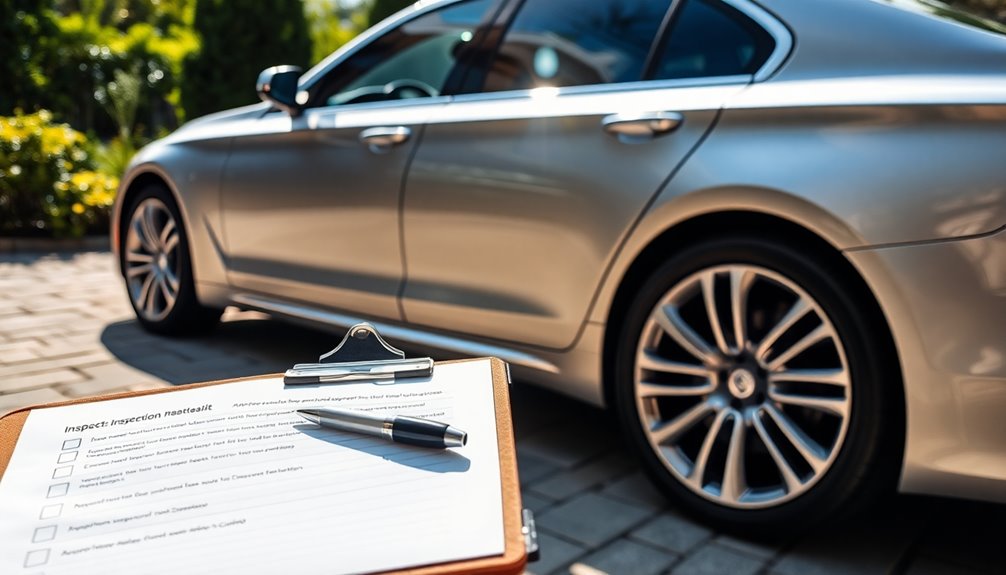Buying out your car lease is simple if you follow these five steps. First, understand the lease buyout process by contacting your leasing company for details. Next, evaluate your vehicle's condition by inspecting it and researching its market value. Then, calculate the total buyout costs, including taxes and fees. After that, explore financing options, such as bank loans or dealer financing, to find the best rates. Finally, complete the buyout transaction by filling out the necessary paperwork and updating your insurance. You'll find that the process can be smooth and straightforward with the right information.
Key Takeaways
- Contact your leasing company to obtain a buyout package with the residual value and any associated fees.
- Research the current market value of your vehicle to assess the financial viability of the buyout.
- Calculate the total buyout cost, including residual value, remaining lease payments, taxes, and fees.
- Explore financing options, such as loans from banks or credit unions, to fund the buyout.
- Complete the necessary paperwork for the buyout, ensuring to update your insurance for the newly owned vehicle.
Understand the Lease Buyout Process
Understanding the lease buyout process is vital for anyone considering purchasing their leased vehicle. A lease buyout allows you to acquire your car either at the end of the lease term or earlier, depending on your lease agreement's terms. The buyout price is typically based on the vehicle's residual value, which reflects its estimated worth at lease end.
To kick off the buyout process, you should contact your leasing company and request a buyout package. This package will include the residual value, any remaining payments, and applicable fees.
Before making a decision, evaluate your vehicle's current market value against the buyout price to guarantee the purchase is financially beneficial for you.
Once you've agreed on the buyout terms, you'll need to complete the necessary paperwork and arrange for payment. This step is fundamental for finalizing the ownership transfer of the vehicle.
Evaluate Vehicle Value and Condition

Evaluating your vehicle's value and condition is essential before committing to a lease buyout. Start by researching the current market value of similar vehicles using online resources or appraisal tools. This will help you determine if the lease buyout price is competitive.
- Inspect your vehicle for any signs of damage or excessive wear.
- Review maintenance records to verify proper care.
- Check the mileage to confirm it aligns with lease terms.
Look closely at your vehicle's condition and mileage against comparable models. This comparison will give you a clear idea of its fair worth and aid in your buyout decision.
If your mileage exceeds the limits, don't worry—buying the car may mitigate potential penalties. A thorough inspection can uncover any issues that might lead to additional costs down the line.
Taking these steps not only helps you evaluate the vehicle value accurately but also guarantees you're making an informed decision about your lease buyout. By being diligent in your assessment, you can secure a competitive price and avoid unwanted surprises after the purchase.
Calculate Total Buyout Costs

To accurately calculate total buyout costs, you'll want to start with the residual value of your vehicle, as outlined in your lease agreement. This value represents your car's estimated worth at the end of the lease term and serves as the foundation for your lease buyout amount.
Next, add any remaining lease payments due as part of the buyout process.
Don't forget to include applicable local or state sales taxes on the buyout price, as they can considerably affect the total cost.
You should also account for dealer fees, which may include documentation, title transfer, and preparation charges—these can vary by dealership and location.
If you plan to finance the buyout, factor in potential financing charges, as interest rates will influence the overall expense.
Finally, consider maintenance costs or potential repairs that may arise after the buyout, ensuring you're fully aware of your financial commitment.
Explore Financing Options

How can you make the most of your financing options when buying out your car lease? First, explore various avenues like banks, credit unions, or dealer financing. Comparing interest rates is essential to secure the best deal for your lease buyout.
- Consider a lease buyout loan tailored specifically for this purpose.
- Look into down payment requirements to avoid unexpected costs.
- Be aware of your credit score, as it influences your APR and monthly payment amounts. Having a good credit score can lead to better loan terms and lower overall costs.
Getting pre-approved for a loan can help clarify your budget constraints, showing you exactly how much financing you qualify for.
Keep in mind the total costs of financing, including the APR, which greatly affects the overall price of the buyout. Additionally, understanding the residual value of the vehicle can help you negotiate better terms for the buyout.
Lastly, verify that your monthly payment amounts fit within your financial capacity, ideally not exceeding 15% of your monthly income. Establishing a solid budget can further ensure you stay on track with your financial goals.
Complete the Buyout Transaction

Once you've secured financing, it's time to complete the buyout arrangement. Start by reviewing your lease agreement to understand the buyout price, which usually includes the residual value and any additional fees. This gives you a clear picture of what to expect.
Next, contact your leasing company to obtain a buyout package. This package outlines the total amount due, including applicable taxes and fees. It's essential to guarantee you have the necessary funds available, whether through cash or various financing options, like loans from banks or credit unions.
Once you have all the financial details, gather and complete all required paperwork. This includes the title transfer forms that officially transfer ownership to you. Make sure to fill everything out accurately and submit it to the leasing company to finalize the arrangement.
After your buyout is processed, don't forget to update your insurance policy to reflect your new ownership status. Keeping records of the transaction will also be beneficial for future reference.
Completing these steps carefully guarantees a smooth shift from leasing to owning your vehicle.
Frequently Asked Questions
How Does Car Lease Buyout Work?
A car lease buyout lets you purchase your leased vehicle when the lease ends.
You'll need to check the residual value in your lease agreement, which sets the buyout price. This price may include sales taxes and fees.
To start, contact your leasing company for the exact buyout amount and required documents.
It's also wise to research your car's current market value to guarantee the deal is competitive before committing.
Does Lease Buyout Hurt Your Credit?
A lease buyout itself doesn't hurt your credit score since it's just a financial transaction.
However, if you take out a loan to finance the buyout and miss payments, that can negatively impact your score.
Keep in mind that your credit utilization might increase if the loan adds to your total debt.
On the flip side, making timely payments can actually improve your credit history over time.
What Is the 1 Rule in Car Leasing?
The 1 rule in car leasing states that your total monthly car payment shouldn't exceed 15% of your monthly income.
This guideline helps you manage your budget effectively, ensuring you can cover other essential expenses without financial strain.
By adhering to this ratio, you create flexibility for unexpected costs and maintain responsible leasing habits, preventing situations where you might end up in negative equity.
Following this rule is vital for evaluating any lease agreement's affordability.
What Is the Downside to Buying Out a Lease?
You might think buying out your lease is a smart move, but there are downsides to contemplate.
You'll face unexpected costs like prepayment penalties, sales tax, and registration fees.
Plus, owning the car means you're responsible for maintenance and repairs, which can add up quickly.
If the vehicle's market value drops, you could end up with negative equity.
Conclusion
In the end, buying out your car lease can feel like finding a hidden gem in a thrift store. You've navigated the process, evaluated your ride, and crunched the numbers. Just like scoring that perfect vintage piece, it's all about understanding the value and making it yours. So, take the leap! Completing the buyout transaction means you're not just driving a car; you're owning a piece of your journey. Enjoy the road ahead!










